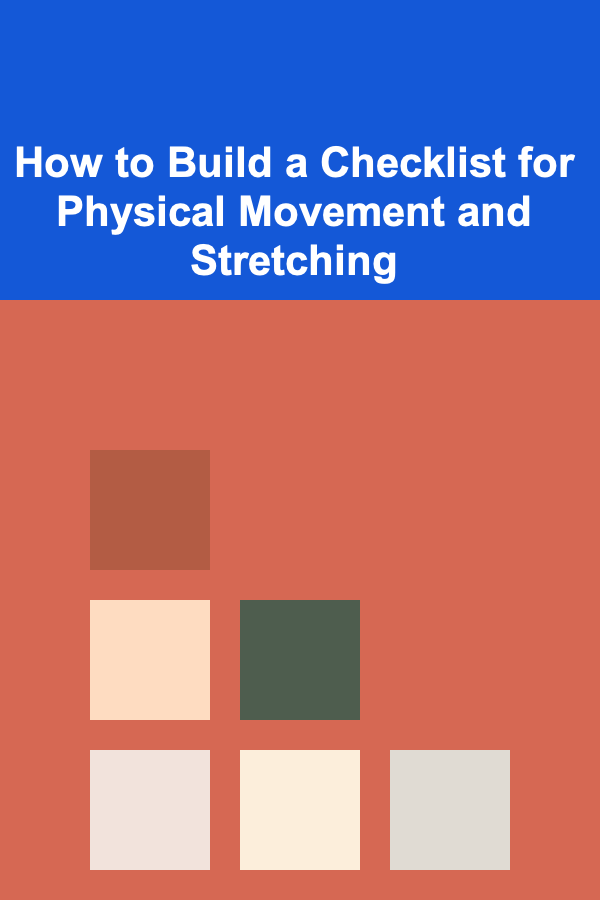
How to Build a Checklist for Physical Movement and Stretching
ebook include PDF & Audio bundle (Micro Guide)
$12.99$11.99
Limited Time Offer! Order within the next:

Physical movement and stretching are essential components of maintaining a healthy lifestyle. Regular physical activity helps to increase strength, improve flexibility, enhance blood circulation, and reduce the risk of injuries. Whether you're an athlete, a fitness enthusiast, or someone who spends long hours sitting at a desk, developing a checklist for physical movement and stretching is a great way to stay on top of your body's needs. In this guide, we'll walk you through the steps to create an effective checklist that ensures a well-rounded physical routine, helping you achieve optimal health.
Why a Checklist?
A checklist can serve as a practical tool to guide your daily physical movement and stretching routines. It's not only about remembering to move; it's about being intentional with your approach. With a checklist, you can:
- Stay consistent with your routines
- Target different areas of the body effectively
- Avoid injury by using proper form
- Track progress and improvements over time
Having a structured plan can help you integrate physical activity into your routine without feeling overwhelmed. Let's break down how to create an effective checklist.
Define Your Goals
Before building a checklist, you need to define your goals. What do you want to achieve through physical movement and stretching? Understanding your goals will help tailor your checklist to your needs. These could include:
Common Goals:
- Increase Flexibility: If your goal is to improve flexibility, focus on dynamic and static stretches that target key muscle groups.
- Strengthen Muscles: For those interested in building muscle strength, incorporate strength-building exercises like squats, lunges, and push-ups into your checklist.
- Enhance Posture: If sitting or standing for long periods is an issue, movements and stretches that promote good posture will be crucial.
- Improve Mobility: For joint mobility, you'll need to focus on exercises that increase the range of motion in your hips, shoulders, knees, and other joints.
- Relieve Tension and Stress: If your primary goal is stress relief, then stretching and movement routines designed to promote relaxation and reduce muscle tension will be the focus.
How to Implement:
- Be clear about your goals, as this will shape the types of stretches and exercises you include in your checklist.
- Consider long-term and short-term goals, allowing your checklist to evolve over time as your body becomes stronger or more flexible.
Include Warm-Up Movements
Warming up is crucial before any physical activity. A proper warm-up increases blood flow to your muscles, reduces stiffness, and prepares your body for more intense activity. Incorporating dynamic movements as part of your warm-up ensures your muscles are ready for stretching or exercise.
Warm-Up Checklist:
- Arm Circles: Start with small circles and gradually increase the size to loosen up the shoulder joints.
- Leg Swings: Swing one leg forward and backward, then switch legs, to open up the hips.
- High Knees: This engages your core and helps get your blood flowing.
- Jumping Jacks: A great way to increase your heart rate and prepare your entire body for movement.
- Torso Twists: Rotate your torso from side to side to increase spinal mobility.
How to Implement:
- Include 5-10 minutes of warm-up exercises at the beginning of your checklist. Customize this part depending on the area of focus for your session (e.g., upper body, lower body, full body).
- Avoid static stretching during the warm-up. Dynamic stretches are more effective in increasing blood flow.
Target Major Muscle Groups
A comprehensive checklist should focus on different muscle groups throughout the body. Targeting major muscle groups will improve flexibility, strength, and overall mobility. Ensure that your checklist includes movements that engage both the upper and lower body.
Lower Body Movements:
- Squats: Strengthen the glutes, quads, and hamstrings.
- Lunges: Work the legs and improve balance and coordination.
- Hip Bridges: Target the glutes and lower back, improving hip flexibility.
- Hamstring Stretches: Help increase flexibility in the hamstrings and lower back.
Upper Body Movements:
- Push-Ups: Strengthen the chest, shoulders, and arms.
- Pull-Ups or Rows: Great for building upper back and arm strength.
- Shoulder Rolls and Stretches: Focus on loosening the shoulders and upper back.
- Chest and Bicep Stretches: To prevent tightness and improve posture.
How to Implement:
- Each session should include movements for both the upper and lower body.
- Be sure to balance strength and stretching exercises for each muscle group. For example, after doing squats or lunges, follow them up with stretches for the hamstrings and calves.
Incorporate Mobility and Flexibility Exercises
Mobility exercises focus on improving the range of motion of your joints, while flexibility exercises help elongate the muscles. These are essential for preventing injuries, improving posture, and maintaining overall body functionality.
Mobility Exercises Checklist:
- Cat-Cow Stretch: Helps increase spinal flexibility and mobility.
- Hip Openers: Use hip circles or pigeon pose to improve hip mobility.
- Ankle Circles: Keep your ankles flexible and prevent stiffness from long periods of sitting.
- Thoracic Extensions: Open up the upper back and rib cage, which is particularly helpful for people who sit for extended periods.
Flexibility Exercises Checklist:
- Hamstring Stretch: Target the back of your legs for better mobility.
- Quadriceps Stretch: Stretch the front of the thighs to prevent tightness.
- Triceps and Shoulder Stretch: Increase flexibility in the shoulders and arms.
- Lower Back Stretch: Relieve tension from the lower back by bending forward or performing a child's pose.
How to Implement:
- Dedicate 10-15 minutes to mobility and flexibility exercises.
- Aim for a combination of dynamic stretches and static holds (30-60 seconds) to get the best results.
- Target areas where you feel stiffness or discomfort most.
Add a Cool-Down Routine
Cooling down is just as important as warming up. It helps lower your heart rate gradually and prevents your muscles from tightening after exercise. A proper cool-down allows your body to return to its resting state while maintaining flexibility and promoting recovery.
Cool-Down Checklist:
- Deep Breathing Exercises: Helps bring your heart rate back to normal and promotes relaxation.
- Forward Fold Stretch: A simple stretch to relax the hamstrings and lower back.
- Seated Stretching: Sit on the floor and stretch your legs forward, reaching for your toes to lengthen the spine.
- Child's Pose: A relaxing yoga pose that gently stretches the back and hips.
How to Implement:
- Spend at least 5-10 minutes on cool-down stretches.
- Focus on deep breathing and longer static stretches during this phase to enhance flexibility and relax your body after physical activity.
Track Progress and Adjust Regularly
The key to any successful checklist is consistency. Track your progress regularly to ensure you're improving. Keeping notes of what stretches or exercises are helping and which areas need more attention will guide you in adjusting your checklist to your evolving needs.
How to Track:
- Journal Your Sessions: Write down your physical activity and stretches, noting how your body feels before and after the routine.
- Use Apps: Many fitness apps allow you to track flexibility, mobility, and strength progress.
- Assess Flexibility and Strength: Periodically reassess your progress through measurements or by noting improvements in performance.
How to Implement:
- Adjust your checklist every 4-6 weeks to keep it challenging and aligned with your progress.
- If certain movements become too easy, replace them with more advanced exercises.
Conclusion
Building a checklist for physical movement and stretching is a simple yet powerful tool to maintain a healthy, flexible, and strong body. By setting clear goals, targeting all major muscle groups, incorporating mobility and flexibility exercises, and tracking your progress, you can ensure that your physical routine is well-rounded and effective. Whether you're just starting out or are already experienced, using a checklist can keep you accountable and motivated, ensuring you continue to move forward on your health journey.
Reading More From Our Other Websites
- [Organization Tip 101] How to Store Bulk Items for Long-Term Freshness
- [Home Cleaning 101] How to Clean Your House Using the "One Hour" Method
- [Home Storage Solution 101] How to Organize Your Garage for Better Functionality
- [Organization Tip 101] How to Establish a System for Incoming Mail and Paperwork
- [Home Renovating 101] How to Plan a Whole-House Renovation Without Feeling Overwhelmed
- [Home Budget 101] How to Make Your Home More Sustainable While Staying on Budget
- [Home Family Activity 101] How to Plan a Family Road Trip with Engaging Activities
- [Personal Care Tips 101] How to Choose the Best Moisturizer for Your Skin Type
- [Personal Care Tips 101] How to Optimize Your Personal Care for an Active Lifestyle When You're Constantly on the Go
- [Home Renovating 101] How to Install a Backsplash Tile: A Comprehensive Guide

How to Invest in International Markets for Greater Diversification
Read More
How to Maximize Small Apartment Space with Smart Layouts
Read More
Saving on Cell Phone Bills: The Best Plans and Tricks to Cut Costs
Read More
The Passive Income Potential of Deep Learning in the AI Space
Read More
How To Design Album Art and Music Covers
Read More
10 Tips for a Picnic on a Budget
Read MoreOther Products

How to Invest in International Markets for Greater Diversification
Read More
How to Maximize Small Apartment Space with Smart Layouts
Read More
Saving on Cell Phone Bills: The Best Plans and Tricks to Cut Costs
Read More
The Passive Income Potential of Deep Learning in the AI Space
Read More
How To Design Album Art and Music Covers
Read More